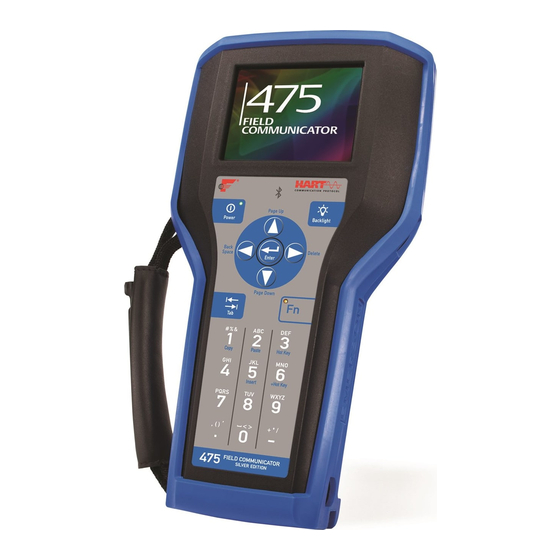
Table of Contents
Advertisement
Introduction
Explosions could result in serious injury or death:
Use in an explosive environment must be in accordance with the appropriate local,
national, and international standards, codes, and practices. Please review the
Reference Information and Product Certifications sections of the 475 Field
Communicator User's Manual for any restrictions associated with safe use.
Electrical shock can result in serious injury or death.
This device complies with Part 15 of the FCC Rules. Operation is subject to the
following two conditions: (1) this device may not cause harmful interference, and (2)
this device must accept any interference received, including interference that may
cause undesired operation.
©2009 Emerson Process Management. All rights reserved.
HART is a registered trademark of the HART Communication Foundation.
F
is a trademark of the Fieldbus Foundation.
OUNDATION
IrDA is a registered trademark of the Infrared Data Association.
Bluetooth is a registered trademark of the Bluetooth SIG, Inc.
AMS Suite is a registered trademark of Emerson Electric Co.
The Emerson logo is a trademark and service mark of Emerson Electric Co.
All other marks are the property of their respective owners.
INTRODUCTION
The 475 Field Communicator Getting Started Guide provides basic guidelines,
precautions, and setup information for the 475 Field Communicator. It does not provide
in-depth instructions for configuration, diagnostics, maintenance, service,
troubleshooting, or Intrinsically Safe (IS) installations. Refer to the 475 Field
Communicator User's Manual on the Resource CD or www.fieldcommunicator.com for
more instructions.
The 475 Field Communicator supports HART and F
you configure or troubleshoot in the field. Electronic Device Description Language
(EDDL) technology enables the 475 Field Communicator to communicate with a
variety of devices independent of device manufacturer.
WARNING
WARNING
OUNDATION
fieldbus devices, letting
3
Advertisement
Table of Contents

Summary of Contents for HART 475
- Page 1 INTRODUCTION The 475 Field Communicator Getting Started Guide provides basic guidelines, precautions, and setup information for the 475 Field Communicator. It does not provide in-depth instructions for configuration, diagnostics, maintenance, service, troubleshooting, or Intrinsically Safe (IS) installations. Refer to the 475 Field Communicator User’s Manual on the Resource CD or www.fieldcommunicator.com for...
-
Page 2: Working In A Hazardous Area
475 Field Communicator Overview 475 FIELD COMMUNICATOR OVERVIEW The portable 475 Field Communicator includes a color LCD touch screen, a Lithium Ion battery (Power Module), a SH3 processor, memory components, and integral communication and measurement circuitry. When using the 475 Field Communicator to communicate with devices, follow all standards and procedures applicable to the location. - Page 3 475 Field Communicator Overview Figure 1. 475 Field Communicator ® IrDA Interface (top) HART and F Strap attachment OUNDATION fieldbus Communication (top) Terminals (top) Touch Screen Display ® Bluetooth Light Power Key and Backlight Key Light Strap Strap Attachment Attachment...
-
Page 4: Battery And Power Supply/Charger
The battery can be charged separately or while attached to the 475 Field Communicator. A full charge takes approximately two to three hours, and the 475 is fully operable when charging. An overcharge condition will not occur if power supply/charger remains connected after charging completes. - Page 5 Failure to comply will void the IS approval. 4. With the 475 Field Communicator still face down, ensure the two battery retaining screws are loose. 5. Align the battery with the sides of 475 Field Communicator, and carefully slide the battery forward until it is secure. CAUTION The connector pins may be damaged if the battery and 475 Field Communicator are improperly aligned.
- Page 6 1. Remove the protective rubber boot, if attached. 2. With the 475 Field Communicator off, place it face down on a level, secure surface. 3. Loosen the two battery retaining screws until the top of each screw is above the top of the 475 Field Communicator.
-
Page 7: Connecting To A Device
Connecting to a Device CONNECTING TO A DEVICE Use the provided lead set to connect the 475 Field Communicator to the loop, segment, or device. Three communication terminals for the lead set are on the top of the 475 Field Communicator. Each red terminal is a positive connection for its protocol, and the black terminal is a common terminal shared by both protocols. -
Page 8: Waste Disposal
Emerson sales representative for information on discarding any part of the 475 Field Communicator. For customers in all other world areas, if it is necessary to discard any part of the 475 Field Communicator, follow the waste-disposal regulations applicable in your location. -
Page 9: European Directive Information - Ce Compliance
Intrinsically Safe for use in Class I, Zone 0, Ex ia IIC T4 (Ta = 50°C) hazardous locations when connected as indicated in the control drawing 00475-1130 in the 475 Field Communicator User’s Manual. See the control drawing for input and output parameters. - Page 10 ATEX Intrinsic Safety Certification No.: BVS 09 ATEX E 023 II 2 G (1 GD) Ex ia IIC T4 (-10°C ≤ Ta ≤ +50°C) 1180 HART Intrinsically Safe Electrical Parameters Input Parameters = 30 Volt DC = 200 mA = 1.0 Watt Output Parameters = 1.9 Volt DC...



Need help?
Do you have a question about the 475 and is the answer not in the manual?
Questions and answers